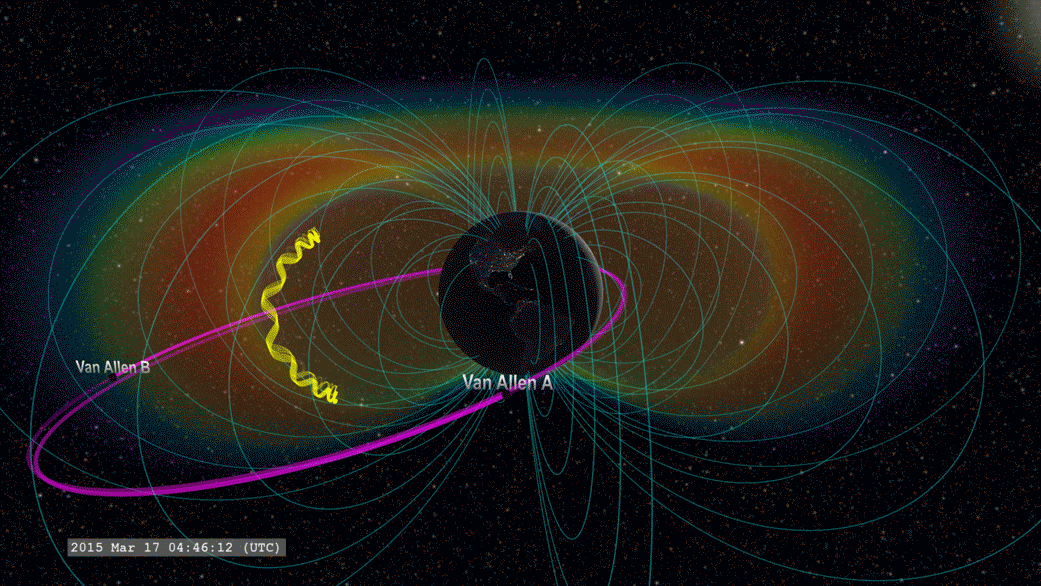Listen to the Eerie Whistling 'Chorus' That's Supercharging Radiation Near Earth
The blazing-fast particles that whirl through Earth's radiation belts are propelled mostly by whistling "chorus" waves, according to new research from two NASA satellite missions.
Earth's magnetic field traps energetic charged particles in two giant, doughnut-shaped swaths around the planet called the Van Allen radiation belts, which extend between 620 and 3,700 miles (1,000 to 6,000 kilometers) from the planet. While you wouldn't want to fly through them, the belts provide protection to the denizens of Earth and people and satellites in near-Earth orbit by stopping high-energy particles that come from farther out and preventing them from reaching the planet.
In 2013, researchers using NASA's Van Allen Probes, which explore Earth's harsh radiation belts, observed that a type of electromagnetic fluctuation called chorus waves propels electrons through Earth's atmosphere. Now, data from that mission, as well as data from the agency's five THEMIS spacecraft investigating Earth's magnetic field, have confirmed that these chorus waves, which can also drive pulsating auroras at Earth's poles, are the main source of the electrons' speedups. [Gallery: NASA's Van Allen Probes]
The electromagnetic waves, "like a flock of noisy birds," NASA officials have said, generate a series of rising chirps in the plasma-filled region surrounding Earth. When those waves interact with charged particles in the upper atmosphere, they can impart their energy in a process called local acceleration. The new work reveals that this process is responsible for energizing particles in the radiation belts 87 percent of the time.
"We've had studies in the past that look at individual events, so we knew local acceleration was going to be important for some of the events, but I think it was a surprise just how important local acceleration was," Alex Boyd, lead author of the new work and a researcher at New Mexico Consortium, in Los Alamos, New Mexico, said in a statement.

Researchers had argued that the speedy particles in the Van Allen radiation belts could come from a process called radial diffusion, wherein solar storms — during which the sun releases large bursts of particles, radiation and magnetic fields — would bump faraway particles closer to Earth over time, where they'd gain energy from the planet's magnetic fields. The other option, local acceleration, would have particles already in the radiation belts whipped into action as they interacted with the electromagnetic waves there.
The new work pinpointed local acceleration as the main culprit because, in most events, they observed "mountains of energetic particles growing in one place" rather than falling in toward Earth, NASA officials said in the statement. While radial diffusion may play a smaller role, it's mostly the chorus waves spurring them on.
Get the Space.com Newsletter
Breaking space news, the latest updates on rocket launches, skywatching events and more!
"The results finally address this main controversy we've been having about the radiation belts for a number of years," Boyd said in the statement.
The new work was detailed May 29 in the journal Geophysical Research Letters.
Email Sarah Lewin at slewin@space.com or follow her @SarahExplains. Follow us @Spacedotcom, Facebook and Google+. Original article on Space.com.
Join our Space Forums to keep talking space on the latest missions, night sky and more! And if you have a news tip, correction or comment, let us know at: community@space.com.

Sarah Lewin started writing for Space.com in June of 2015 as a Staff Writer and became Associate Editor in 2019 . Her work has been featured by Scientific American, IEEE Spectrum, Quanta Magazine, Wired, The Scientist, Science Friday and WGBH's Inside NOVA. Sarah has an MA from NYU's Science, Health and Environmental Reporting Program and an AB in mathematics from Brown University. When not writing, reading or thinking about space, Sarah enjoys musical theatre and mathematical papercraft. She is currently Assistant News Editor at Scientific American. You can follow her on Twitter @SarahExplains.









